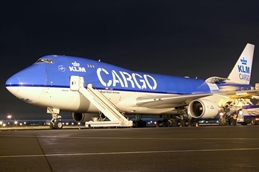
A forwarder is sounding the alarm over the loss of maindeck capacity as airlines continue to take freighters out of service.
“We have seen a reduction in freighter capacity. So far this has not been a problem, but if this is extended further, it will be critical,” warned Thomas Reuter, chief operating officer of Dachser Air & Sea Logistics. Last year, the German logistics company ranked fifth in airborne exports out of Germany. It has its own branches in 38 countries around the world.
Freighter operators have been under pressure from falling yields and high operating costs, a situation exacerbated by the proliferation of widebody passenger aircraft like the B777, which can carry as much cargo as a mid-sized freighter. With ever more B777s and B787s – now joined by A350s – entering service, driven by passenger demand that is outpacing cargo volumes, the available bellyhold capacity is set to keep growing, keeping up pressure on all-cargo operators.
“There is a continued trend around the world to use more belly capacity,” confirmed Jim Ramsey, vice president for the Americas region, global freight forwarding, at UPS.
Several European carriers that traditionally had a strong focus on freighter operations to supplement their belly capacity, such as Air France-KLM, have cut back their maindeck lift drastically and are expected to make further cuts. IAG scrapped leasing contracts for three B747-8Fs last year and now takes space on freighters by Qatar Airways on a Hong Kong-Doha-London routing.
One of the most recent operators to step away from longhaul maindeck operations has been Finnair, which suspended its MD-11F service between Hong Kong and Helsinki in late December.
Asian carriers have been less aggressive in trimming down their freighter capacities – mostly phasing out B747 and MD-11 cargo aircraft as new B777 and 747-8 freighters were delivered – but they are also reducing their freighter fleets. EVA, which fielded as many as 15 large widebody freighters two years ago, is looking to shrink its all-cargo fleet to ten units.
Strengthening demand in the second half of 2014 has markedly improved load factors, but yields remain under pressure, owing to overcapacity, particularly on routes between Asia and Europe. Several Asian carriers have taken to routing some of their US freighters back to base via Europe, both to take advantage of relatively robust transpacific demand eastbound and to limit their freighter flights from Asia to Europe.
One reason for the inexorable rise in belly lift has been the growth of the Middle Eastern airlines. “With the increased belly lift to Europe, especially over the Middle East, we have been able to move more traffic on belly lift in 2014 than we typically did,” said Vito Losurdo, vice president of global airfreight services at UPS Supply Chain Solutions.
He added that his outfit still moves significantly more traffic on freighters than on passenger aircraft. Because of the volumes involved and the size of some shipments, there is still a need for freighter lift, he added.
In response to shrinking all-cargo lift, Dachser has adjusted its capacity planning in recent months, but Reuter stressed that the forwarder would not be able to do without scheduled freighters altogether.
“Especially at points where we operate air freight gateways the use of such capacity brings a decisive advantage,” he remarked. “We are very active in the automotive sector, where freighter solutions are necessary. Therefore we see in future a high demand for freighter aircraft in certain trade lanes and in select sectors of industry.”
Further erosion of maindeck capacity could lead to different pricing structures for maindeck and bellyhold lift, as forwarders struggle to find freighter capacity on some sectors, Reuter reflected.
“You cannot cover all (maindeck lift needs) with charters,” he said.
Ramsey stressed the need for a mix of maindeck and belly lift. Recent years have favoured airlines that operate both passenger and freighter aircraft, he noted. “We look for carriers that have enough capability for these two,” he said.
By Ian Putzger
Air Freight Correspondent | Toronto




